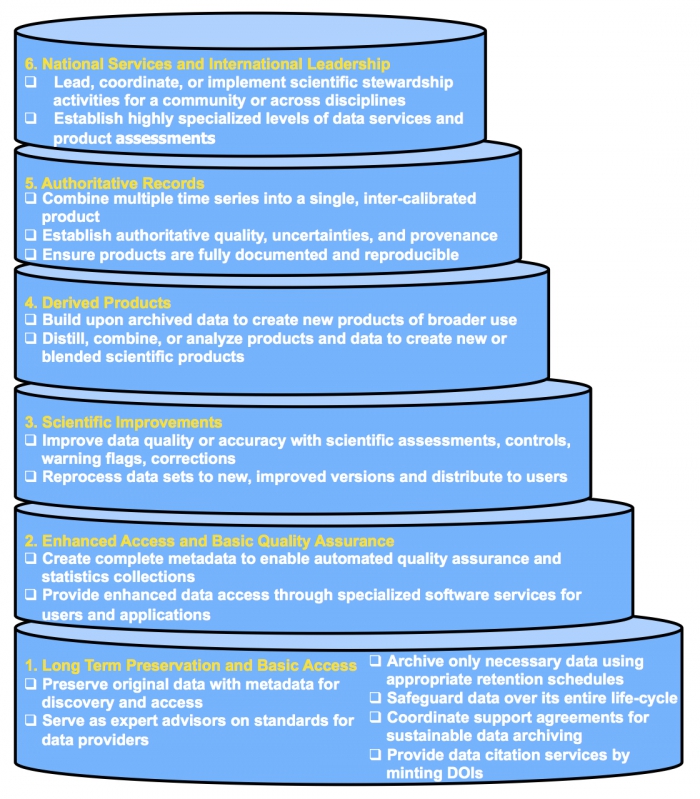By: Sheekela Baker-Yeboah, University of Maryland, Co-Principal Investigator Arctic Data Center; Krisa Arzayus, Deputy Director, NOAA/NESDIS/National Centers for Environmental Information (NCEI), Center for Coasts, Oceans, and Geophysics; Kenneth S. Casey, Deputy Director, NOAA/NESDIS/NCEI, Data Stewardship Division; and Matthew B. Jones, National Center for Ecological Analysis and Synthesis (NCEAS), Principal Investigator Arctic Data Center
The National Oceanic and Atmospheric Administration (NOAA) National Environmental Satellite, Data, and Information Service (NESDIS) National Centers for Environmental Information (NCEI)1 serves as the Nation's archive for oceanographic, atmospheric, climatic, geophysical, and space-weather data. NCEI archives data from national and international partners, and its holdings of over 14 petabytes include a wide range of data types from the bottom of the ocean to the surface of the sun and from around the world.
NCEI is part of an Arctic-focused project partnership: the National Science Foundation (NSF) Arctic Data Center (Budden, Jones, and Schildhauer, 2016) (see also: Witness the Arctic, Spring 2016), which encompasses the National Center for Ecological Analysis and Synthesis (NCEAS) at U.C. Santa Barbara, DataONE at the University of New Mexico, and NCEI at NOAA. This joint collaboration provides long-term data archive, distribution, integration, and public access services for Arctic data within the purview of NSF and NOAA and will provide more organized and discoverable Arctic data to user communities. As such, NCEI, which currently participates in the DataONE Federation as a Tier 1 member2 node providing read-only access to data, will elevate its status to Tier 4 to support upload and replication of data from the Arctic Data Center to NCEI and provide supporting data storage, curation, and discovery services. This partnership will leverage existing NCEI scientific data stewardship infrastructure, products, and expertise.
1 NCEI, formerly the National Oceanographic Data Center (NODC), National Climatic Data Center (NCDC), and National Geophysical Data Center (NGDC).
2 More information about Tier levels in the context of DataONE is available on the DataONE website.
NCEI Levels of Scientific Stewardship
NCEI provides long-term scientific stewardship of environmental data collected from a variety of data providers. Data are routinely archived and made discoverable and accessible for current as well as future use by NOAA and the Nation. In particular, these data support NOAA's efforts in environmental intelligence in monitoring climate stressors on marine ecosystems and supporting the resilience of connected communities, including the Arctic. NCEI organizes its data stewardship into six conceptual levels (see Figure 1). At the most fundamental level, NCEI works to provide long-term preservation and access to data and metadata; create standards-compliant metadata to describe it; and support its discovery and use. At the second level of stewardship, NCEI provides enhanced access to data, supporting functions such as on-line visualization; slicing or subsampling; more thorough, detailed, or complete metadata; and automated quantitative characterizations of data quality and extent. At the third level of stewardship, NCEI works to improve data with scientific quality assessments and control, flagging, and corrections. At the fourth level, NCEI generates products such as running means, aggregates, composites, or climatologies. At the fifth level of stewardship, NCEI works to create data records that are recognized and utilized by the community as authoritative sources of information, including products such as climate data records and multi-platform intercalibration. Finally, at the highest level of scientific stewardship, NCEI acts as a recognized authority, leading the community in the development of standards or in the practice of scientific stewardship of ocean data.

NCEI New and Upcoming Features
During the upcoming year, NCEI discovery and access capabilities (see Figure 2) will be expanded in collaboration with the NSF Arctic Data Center to develop new capabilities and features supporting Arctic researchers and general users. NCEI is in the process of elevating its DataONE Member Node status by setting up replication to repositories in DataONE. Prototype development and testing of DataONE Tier 4 replication capabilities are expected to be completed over the next two years for the NCEI repository.

Part of the NCEI Arctic mission connects to advances being made through the NSF Arctic Sciences Section. Shared datasets specific to the NSF Arctic Data Center program and NCEI will have combined data management plans and unified access to products in an effort to provide a replica of the NSF holding within the scope of NOAA's mission. These will include support infrastructure, client tools, an extended web submission system to support rich data entities and attributes, and advanced submission features for full replication status. The NCEI Arctic program continues to grow and product development efforts are ongoing. The upcoming NCEI Arctic Data Viewer (see Figure 3) will link to the NSF Arctic Data Center Discovery Portal and Upload Tool to facilitate a more organized and discoverable approach for user communities to Arctic datasets.

References
Kenneth S. Casey. Member Node Description: NCEI (National Centers for Environmental Information) Oceanographic Data Archive. Version 1.0. 2016. https://www.dataone.org/sites/default/files/member-nodes/documents/memb…
Budden, E. Amber, Matthew B. Jones, Mark P. Schildhauer. The NSF Arctic Data Center: A New Home for Arctic Research Data. 2016 Arctic Research Consortium of the United States, Spring Issue 2. https://www.arcus.org/witness-the-arctic/2016/2/article/25687
